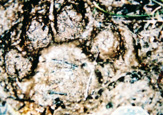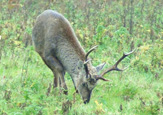





Mande Burong in Meghalaya, India (Page 3 of 3)
Before the expedition, I had not even heard of the north eastern Indian state of Meghalaya, but of course heard of Assam. It had never occurred to me to ponder over a map and imagine the areas in the world where this kind of animal existed. I did after I arranged to go on the expedition. I closely looked at the maps of Asia and especially India, Myanmar, China and Bhutan. I realised that the animal needed to be as far away from humans as possible without putting up high in the mountains of the Himalaya. There also needed to be warmth and ample food and cover. There were many places in these areas that had most of these components but some areas seemed more likely than others. Meghalaya was one that stuck out as well as the areas of Nagaland and other areas between India and Burma and southern china. I looked at the other wildlife the biodiversity of certain regions around. Meghalaya seemed too populated with humans, but it was not until I got there that I realised that although it was heavily populated in many areas, there were many areas of wilderness, and places where such animals could possibly survive even in the presence of man at some point. If all their needs were there with a small amount of people then perhaps they would put up with the risk of one or two encounters with man. The ability to hide must be good, and a total change in behaviour must be made in order to survive gun happy hunters. There are many areas where the Garo people do not go, even in daylight. There are a few national parks where hunting is banned, although there is always going to be poaching, and most of this will be at night. The Mande burong would have to be on its guard all the time, with a true fear of man.
The Garo hills are low hills, but many. The landscape is very undulating, range after range traverse the region covered in jungle. It is a real mixture of evergreen forest, mainly young, but also old forest in the national ,parks, many of the larger trees do not exist, but with little evidence of large scale destruction. There is no large commercial logging going on, and what slopes are cut, are quickly covered in growth in the form of creepers and vines, palms and bananas. The undergrowth is thick and is thicker than the understory of the old forests. There is a mosaic of rice fields usually in the lowest lands surrounding the river and stream valleys. Water is everywhere in the form of hill streams, flowing in different directions. There are hundreds of little streams flowing down from the many hill ranges. This is a major reason as to how the animal exists in this region. I do think that the Mande burong uses these streams as routs not just from A to B, but feeding places. They are the easiest routes to follow in the thick jungle and they are usually open, or not so overgrown. A tall person can walk for hundreds of miles upright without having to stoop. The stream beds are basically solid, in the way of rock and sand and silt. The streams are always moving and sluggish waterways do not exist except the main rivers and their tributaries of which are many in the wider valleys. The rocks in the streams are mostly large. Gravel size stones are the base of many of the streams with larger fist size rocks, and then larger football sized ones. Within these streams will be even larger chair sized to car sized rocks and some streams are just made up of the latter two. The stream bed is thus solid and easy to walk on even if one is a very heavy animal such as a large humanlike ape. Even buffalo can traverse many of the streams, yet many would be impassable for quadrupeds, but for bi pedal animals it would not be such a problem, especially if it can hold on with hands in slippery areas, and some areas certainly are slippery on the rocks, but with a tough bare foot, it would be easy. The streams are also cool and clear. They all have life in them. Several species of freshwater crab and shrimps can be found; the crabs can be quite large and are easy to find sheltering under the rocks. Small fish are plentiful and so are amphibians. Ion some areas where there is still water, the populations of bullfrogs are immense. If one walks along the banks of even a small pond, typically over one hundred specimens may lunge into the water from the bank sides. The footprints of civets and small cats such as fishing cats can be found along the silty banks. Many streams wind there way through bamboo forests, others through plantations of bananas, tea, chillies and many other kinds of farmed vegetables, but the majority of the hill streams run through virgin jungle. The streams are basically highways for certain animals.
Most of the reports of Mande burong come from the streams themselves or from areas not far from them, or other rivers. It would make sense therefore to assume that these streams are central to the movements of the animal and its feeding habits.
It is debatable whether or not the Mande burong eats meat in the way of reptiles, birds or mammals. Would the animal attain all of its daily requirements from just vegetable matter? I think not. The animal is very bulky and tall. If such an animal was a vegetarian, then it would have to spend a lot of time doing nothing but resting and sleeping. Would it actually need more protein in the form of animal life? I think so. The nearest animal to the Mande burong that is solely vegetarian are the Orangs and gorillas, although both species are very different from each other in behaviour, physique and eating habits. Both species are not very mobile. The orang utan spends much time in the tree tops doing little else but feeding, as the vegetation is basically low in protein. The gorilla is the same; it too spends most of the time digesting cellulose in the form of the vegetation it consumes. Although the gorilla is a social animal and lives in family groups it does not spend a lot of time and energy moving any great distance within a day. This behaviour is typical of the large vegetarians. Chimpanzees on the other hand are omnivorous and may have the luxury of meat several times a week, that meat is usually in the form of other primates or antelopes, and on a regular basis invertebrates in the form of ants and termites, they on the other hand do not loiter around for too long and are regularly on the move. Basically, if a very large primate needs to move around every day, often covering large distances, then it would make sense to eat a more protein full diet in the form of red meat. Also if the primate lives at high altitudes then temperatures would be a problem for a vegetarian, so red meat would allow a healthy fat build up in wintertime. Top carry a huge bulk of muscle around while travelling many miles in a bipedal way would almost certainly mean that the animals would need to eat as much meat as possible. This could mean a whole animal a week, perhaps in the form of a deer, or several marmots or other rodents, even birds and their eggs. It is believed that the big foot of North America as well as the large Yeti of central Asia, often take cattle or yaks. There have been eye witness accounts of them taking large animals and eating the flesh, or carrying the remains around with them, or stashing them in places.
While in Meghalaya, we did not hear of any accounts of the Mande burong taking cattle or goats but I would not be surprises if accounts have been incorporated into the literature or folk tales in the past. I do believe that the animal is omnivorous like us, and would not miss the opportunity to eat fresh meat in the form of mammals or birds. Smaller animals in the form of reptiles and fish would give the animal much needed protein and if there were enough of these animals within its territory if it indeed has one, the I am sure that this diet along with much plant and fruits would sustain it. While on our search for the animal, we found remains of freshwater crabs that had been caught by over turning of stream rocks. The crabs are rather small, but many of them along with bamboo and insects could give all the daily requirements one animal needs. The Mande burong would not need to eat large bones but small ones from the reptiles or small mammals would give it all its calcium requirements. If the villages found the remains of Mande burong eaten goat for example, maybe they would attribute it to the doings of a leopard or tiger, or one of the several other species of cats that could be living in the region. So far there have been no reports of the Mande burung attacking or eating humans as there have been with a few of the other big man like apes in other parts of the world, and if not, then maybe it has good reason to be shy of man, or perhaps it is not such a meat eater after all. Maybe it does not travel large distances at all, and I may have been lickenening it to the Yeti, of the higher more remote areas of the Himalaya It would after all seem to be very similar in appearance, but maybe the fact that it lives in more hospitable a climate with more in the way of fruit and small animals, then maybe it has less of a need for red meat.
The Garo tribes have always had a tradition of hunting, and much of the evergreen forest animals that existed have since been hunted out of existence. This would have had an effect on the hunting ability of the Mande burong and maybe it would have to eat more vegetation or fruit that usual, or maybe this has led it too eat more crustaceans and insects. Maybe in the past the animal only ate fruit, leaves and deer. It could well have been a scavenger and robbed the kills of tigers or leopards. Mande burong is a tall, massive and strong beast and could easily win a tussle with a tiger.
If we can imagine the area before modern humans arrived, then we can see a forest of great richness of biodiversity and the Mande burong would have been the feared animal at the top of the food chain. Perhaps the species of deer and other primates did not fear it as much as the cunning leopard or the tiger , but I am sure that the animal would not have been able to sit within a herd of deer and they be totally oblivious like a scene of lowland gorillas in Africa. It is also strange that such a large animal would naturally be loners. I do think that this due to the rarity of the beast and not by evolutionary choice. I can imagine them living in small family groups of perhaps two or three females with young and a male. They would share any meat and larger vegetation brought back by a male or female that may have gone out hunting. Maybe the animals did once stay for short periods of time in one area that was rich in food before moving on, and making rough camp. It is said that the animal makes a nest and from one witness report, it would seem a neatly constructed shelter. The witness stated that when he peered through the jungle at the sound of whimpering noises he saw a distinct lean too kind of shelter of intertwined bamboo stems and a small inner canopy within. Also the floor was cleared of debris and was worn smooth. This would suggest that the animal has weaving skills more akin to early hominids.
The description of the animal would certainly seem to be of a slimmer animal than a gorilla and not so much the body mass of say the /American Bigfoot and most reports of the yeti. It seems to resemble more the Almasti of the Russian region. Looking at the sketches made by eye witnesses, it seems to have a touch of Orang utan look about it. I wonder then if it may be related to Orang pendeck. The head seems to be domed in a similar way to that of the African gorillas, and this feature seems to be prevalent in most of the man apes. Orang on the other hand does not have a domed head. The colour of the hair that is said to cover the whole of the body is brownish black, along with a distinctive musky smell. This also is common with the other alleged man apes. The hair is said to be long, especially on the back of the head and neck. When pictures or artists impressions of various apes and ape men were shown to the eye witnesses, it was interesting to watch each person carefully look at each picture and dismiss them one by one except the artists impression of Gigantopithecus, and state that it looked like that, but with longer hair on its back of the head, neck and back. This is interesting. This feature is not so apparent with the North American big foot descriptions, and it certainly is not to be found in modern day chimps or gorillas, but it does have slight similarity with orang utans, and I would assume certainly with orang pendeck. This also has a similarity with humans, especially ancient hominids, as they too are more likely to have had long hair at the back of the head, and neck.
The size of the footprints do not necessarily correspond to the animal height, but if the animal is slimmer than some of the other alleged man apes, then it would be reasonable to assume that it is tall rather than broad. A giant foot does not mean that it has to be huge. We are simply comparing it to the modern human foot, body size relation. Most reports of the animal do seem to suggest that it stands upright at between six and ten feet tall, these judgements may be unreasonable as considering that most witnesses are Garo people and they may not have a very good sense of measurement as modern man has. Sizes of animals are usually exaggerated as it looks good to impress, and that has happened in most tales or observations of cryptids and monsters. I am sure that the animal is tall, perhaps seven or eight feet. It may have a large foot in relation to body size, but, as our findings suggest, via footprints that we found, it would seem that the foot is broad, which would mean a broad leg, and so a broad body, similar to the depictions of man apes in other regions of the world. It may seem to show that the animal does not walk while putting most pressure onto its heal. The footprints were deeper in the ground at the front of the foot region than the back. This also relates to findings of big foot and other man apes. It would seem that it can walk on its toes at times, despite not having a foot arch, or at least half walk on its toes. This may give it balance when walking on river bed silt or it may give it grip on slippery rocks and mud, or it may give it speed and acceleration. The footprints also suggest that the animal has smaller toes than that of many of the alleged Bigfoot footprints, and even some of the yeti footprints. There is certainly no opposing thumb as in the great apes. The animal obviously has not been a tree climber for a very long evolutionary time span. Reports also suggest long figure and toe nails, maybe similar to humans but much thicker and stronger.
Most reports of the Mande burung are from the national parks of Norkrek and Balpakram as well as from Tura peak. Tura peak is relatively near to the town of Tura; in fact the peak dominates the town, with its steep hillsides. The national parks are more remote and cover large areas, with little hunting in them. We did not find any evidence in Balpakram, but ewe did not go far and stayed on the well worn track buy vehicle first then on foot for a small part of the way. There was evidence of elephant, buffalo and hog deer, also the scats of cats such as golden or clouded leopard. There were sandy areas of trackside along side the very rocky terrain but not footprints of Mande burung. The land was dry and we experienced no rain as it was still the dry season, being November, it was technically autumn. During the monsoon season in June and July I would expect more footprints to be found, that is if indeed the animals remain in the region and are not seasonably migrating. It would seem that most encounters are in the autumn and winter as apposed to the warmer and wetter summer months. This does not mean much in itself, but it may mean that the Garo people do not hunt so much in wet weather, maybe the many small rivers and streams could be very dangerous to travel along. There then may be fewer reports. The autumn time is when most plants fruit and bananas especially at the end of summer time. This is a subtropical area so seasons in respect of fruiting plants are not that well defined but there is a general rule. Global warming has also had its effects on the plant life and the winters are now much warmer than in previous years.
Meghalaya is very like an island in respect to its geography. It is a vast area that would fit snugly within southern England, yet it is surrounded by the vast plains of Bangladesh to the South and West, a large divide of rivers and mountains to the East, which really could be the most likely entry and exit into the region. To the North lies the great Brahmaputra River, very wide and acting as a natural barrier between Assam and Bhutan. It seem unlikely the Mande burung crosses these regions on a back and forth basis. If it is migrating solely on seasonal grounds such as to escape cooler temperatures from the north, then the animals would have to be coming through the North east on a very long run through the northern highlands of Myanmar through the Naga land before entering the East Kasi hills district and then into the Garo hills. It would seem a long hall for a large primate to do.
It is even more unlikely that the Mande burung comes down from Bhutan, as it would have to cross the mighty Brahmaputra River. This river is huge and very wide. It is more like an in land sea at most points, with only a few narrow area in the dry season, yet it is shallow. It would not be impossible for the Mande burung to know the good crossing points of the several wide parts of the main river in the dry season and cross during the night at its lowest point. You are safe areas in which it could do so, but then it would be more exposed in the areas of Assam in-between. There may be corridors of forest connecting remote areas that could act as cover for them. There are also many bridges that the animals could cross, but as yet there are no reports of sightings. It may be that the animals remain in the Meghalaya area without ever needing to move away, but if they do then I would bet that they come from the North East. If indeed they only live in the Garo hills then that would a recipe for disaster, as they would be severely inbred as the number of the animals would seem to be very small. The Mande burung would then seem to be a relict, marooned on an island and doomed to extinction. I do not think that the Mande burung is quite the same as the yeti, but a similar and smaller animal that could be and maybe still be found in Burma and Malaysia.
Whatever it is, it needs to be protected and fully studied. After meeting with eye witnesses and seeing possible signs of the animal in the jungle, I can honestly say that I believe that the animal not only existed, but still exists albeit in very small numbers within Meghalaya.
We found possible footprints in at least two locations. The first sett was in an area along a stream bed where sightings had occurred earlier. We went down into a valley with one of the witnesses. And very soon the first print showed up, and then we found another two at least. All were facing the same direction, upstream. There was little doubt that what we were finding were footprints. We did not jump to any conclusions, but carefully debated all the possibilities. We firstly looked at the shape, a deep depression in the soft silt along the edge of the stream. It was pointing as if the maker had just walked from some large rocks and stepped towards the bank before turning to walk along the edge of the water, or to do a small detour alongside a lush area of vegetation that stretched for a few hundred yards out from the main stream bank. The area upstream for approx fifty yards was overgrown so the animal may have done a short detour in exactly the same way as we did, for safety purposes. Whilst we judged the depression in the silt, it was clear that there were five toes like depressions on the end of a foot shaped area. We firstly looked for a rock that could have been removed. We found none and why would that happen anyhow. The impression was away from the main water and so if a human had moved it, it certainly was not to look for crabs. There was not rock that had been moved. How could a depression appear in silt shaped like a giant foot?
It was about two inches deep into the silt, and when we stood in an area near by and felt the mud, our weight dropped us down to only half the depth. This would imply that the animal was approx twice our weight. The footprint was huge, but the same size as any other print made by a yeti, but the toes were certainly very human like. I am sure that it was not a hoax, as a hoaxer would have made several and made them more clear and obvious. This was not the case here. I have analysed many footprints of wild animals and I am used to looking at all the various forms in which an animal leaves its prints. The way in which the toes were lightly capped off the silty sand was in direct comparison to other animals in a similar situation. The area in which we were in did not have many villages nearby, and there was just a few families living at the top of the gorge. These we spoke to. They did not show any signs of even knowing what we were doing let alone being in a position to hoax Mande burung footprints in a haphazard none obvious manner. We knew what we were looking at. It was obvious as daylight. We were looking at the footprints of an unknown great ape, or hominid. We were all spellbound by our findings alongside the stream that day. The witness was surprised but did not seem to show any signs of sheepish grins or stardom in his eyes. He had seen the animal, and simply took us to where he had seen it, and we found field evidence of it. When we spoke to the several witnesses, they were plainly being honest. They are not like westerners, they do not know about hoaxing. They have no reason too. They are simple friendly tribe’s people who have just a bamboo hut and animals. Two of the witnesses felt so pleased that they had told us, as if a great burden had been removed from their chests, some may have been ridiculed by their peers as many villagers have not believed them, because with any legendary animal comes scepticism and awe, in regard to how the people think. Many Garo folk are deeply superstitious and see it as bad luck to even talk about the animal. Most villagers or town’s folk will believe that the animal did once exist, if not now. Like many of the larger mammal species that existed with them but since disappeared from over hunting, perhaps the Garo people see the Mande burung as being one of the same, yet an animal that was not hunted by them. Despite this, the story of the severed hand in the market stall is intriguing.
Page 1 | Page 2 | Page 3 | Photographs